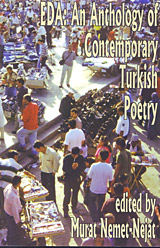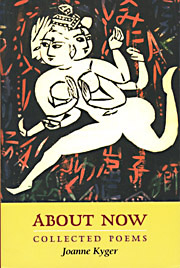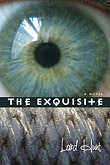|
Jacket 34 — October 2007 — Contents page
Turkish poetry — Canada — Language Poetry — Joanne Kyger — Horace
A free internet literary magazine — Interviews — Reviews — Articles — Poems
Editor: John Tranter [»» Homepage]; Associate Editor: Pam Brown [»» Weblog]
Visit our new [»» Jacket Notes pages]: readings, new books & magazines, blogs, etc.
You may send [»» Letters to the Editor]: please be concise and courteous.
The Internet address of this page is http://jacketmagazine.com/34/index.shtml
We only have time to read for Jacket in June, July and January: please don’t send material out of season.
|
Jacket’s homepage has received over half a million visits since 1997. All issues are available here, featuring thousands of pages of poetry, creative prose, reviews, interviews, author photos, and informative articles. Address:
Jacket magazine
c/- Australian Literary Management
2-A Booth Street
Balmain NSW 2041
A U S T R A L I A
[»»] Electronic mail
ISSN 1440-4737
The word Jacket is the registered business name of this magazine (registration number U2708004) under the Business Names Act of 1962, New South Wales Consumer Protection Agency, NSW Department of Fair Trading. The word Jacket is a registered trademark number 886295 in the Register of Trade Marks, Commonwealth of Australia.

Jacket is sponsored by Australian Literary Management. ALM was founded in 1980 in Melbourne, Australia, and is now based in Balmain, a harbourside suburb ten minutes from the centre of Sydney. ALM looks after the business affairs of more than a hundred authors around the world, negotiating their contracts and managing their careers. You can visit ALM’s
[»»] Internet site.
All issues of Jacket magazine are archived in perpetuity by
[»»] Pandora, Australia’s free Internet Archive at the National Library of Australia.
Plaudits: In January 2000 Jacket was selected for an ‘Encyclopaedia Britannica Internet Guide Award’. Jacket has been chosen as a ‘recommended site’ on a number of international web sites — see our
[»»] About Jacket Page.
Note from the Editor: I cannot accept poetry contributions that I don’t specifically ask for — I don’t have the time or the space to handle them yet. If you’d like to submit a review, article or interview, send a half-page synopsis with your return email address. Because Jacket is free and has no advertising and no source of income, I regret that I cannot offer to pay for contributions.
Copyright Notice: Please respect the fact that this material is copyright. It is made available here without charge for personal use only. It may not be stored, displayed, published, reproduced, or used for any other purpose. The material in this issue of Jacket is copyright © the individual contributors and Jacket magazine, as at the date of this issue.
Copyright Information (for Jacket authors and copyright owners): Jacket asks for single-use non-exclusive electronic world rights, in order to protect your rights from exploitation by others. You retain all copyright, and you may publish the work anywhere in any form at any time. You don’t have to ask Jacket’s permission: just do it. It would be nice if you mentioned previous appearance in Jacket.
Aesthetics in an Information System
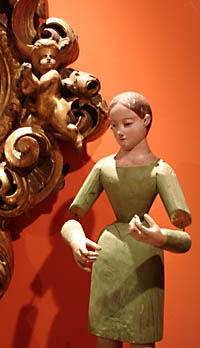
How to play the Air Guitar,
circa 1728. Photo John Tranter.
Something to think about:
Information Technology and Aesthetics: Passive and Active Dimensions
John D Haynes, David Bryan Paradice
Abstract: This paper is concerned with examining and recognizing aesthetics in an Information System (an organization incorporating both humans and information technology). Aesthetics emerge from the wholeness of things, not from specific parts or components. As such, aesthetics may naturally be considered in ‘systems’, and we propose that an effective manner of thinking of aesthetics is to think in terms of ‘themes’. Humans have an extraordinary capacity to capture events thematically. In other words, human beings have a natural sense of aesthetics. To examine aesthetics in an information systems context, we argue that one must consider not only aesthetics that may be perceived by the senses (a passive dimension), but also aesthetics that may be conceived in the mind (an active dimension). This paper draws the conclusion that the benefits of aesthetics in relation to the study of Information Systems, has characteristics similar to the nature and importance of ethics in IS. Also, the study of aesthetics in IS has greater implications than simply recognizing and appreciating beauty and art. The very human capacity for recognizing and appreciating beauty and art is also the same capacity for effective creativity and happiness: the active aesthetic dimension. It follows that if an information system encouraged and provided the enabling circumstances for the human capacity of thematic recognition (as found in the human appreciation of art and beauty) it thereby also provides the ground and the necessary thematically recognizable stimulus for effective creative and visionary organizational management.
— Australasian Journal of Information Systems, Vol 14, No 2 (2007). Full PDF is available at http://dl.acs.org.au/index.php/ajis/article/view/30
|
|
Contemporary Turkish
Poetry
A selection of poems and essays drawn from Eda: An Anthology of Contemporary Turkish Poetry
edited by Murat Nemet-Nejat, published by
Talisman House, New Jersey, and available through Small Press Distribution.
“Thinking, speaking in Turkish is a peculiarly visceral activity, a record of thought emerging… Eda is the play of ideas through the body of Turkish. Not only is it the poetics of Turkish poetry in 20th century, it is the extension of the language itself, the flowering of its inherent potentials as a language. The otherness of Eda is the distance which separates Turkish from English.”
Read the sample of poems [»»] here.
Read the essays [»»] here.
Buy the book [»»] here!
Features
[»»]
Post-Marginal Positions: Women and the UK Experimental/ Avant-Garde Poetry Community, moderated by Catherine Wagner
[»»]
‘Between revelation and persuasion’: Eric Mottram and Robert Duncan: A Compilation by Amy Evans and Shamoon Zamir
[»»]
Lucas Klein: «Stèles» / 古今碑錄, Volumes 1 and 2, by Victor Segalen
About Now, by Joanne Kyger, Introduction by Linda Russo
For decades, Joanne Kyger has played a crucial role in California’s poetry scene. Her poetry has been influenced by her studies in Zen Buddhism and her connection to the poets of Black Mountain, the San Francisco Renaissance, and the Beat Generation. In this issue of Jacket:
[»»]
Linda Russo’s Introduction to the book,
[»»] Jane Falk provides a reader’s response, and
[»»]
Dale Smith looks at Kyger’s developing poetics through her long career, and
[»»] Robert Adamson presents two poems written for Joanne Kyger.
Note:
[»»] Jacket 11 contains a multi-voiced feature on Joanne Kyger edited by Linda Russo.
Interviews
[»»]
From the Hither Side: Innovative Women Poets — Cynthia Hogue and Elisabeth Frost in conversation with Jane Joritz-Nakagawa
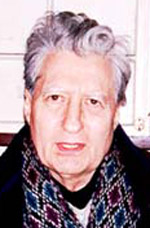
Jackson Mac Low, 1997, photo John Tranter
[»»]
Jackson Mac Low in conversation: Making Poetry “Otherwise”, 28 January 2001
[»»]
Thirteen Ways of Looking At A Vermont Poet: Bob Arnold in conversation with Gerald Hausman
[»»]
Shanxing Wang in conversation with Nathan Brown
Articles
[»»]
What’s Really Going on in Persicos Odi? Art Beck on Horace.
[»»]
Jeff Derksen: “These Things Form Poems When I Allow It”: after John Newlove
[»»]
Laurie Duggan: On Gael Turnbull’s «Collected Poems», with a digression on his aleatory, kinetic and other off-the-page practices
[»»]
John Felstiner: “It looks just like the Cascades” — Gary Snyder’s Eye for the Real World
[»»]
Thomas Fink: The Poetry of Questions
[»»]
Noah Eli Gordon: Considering Chapbooks: A Brief History of the Little Book
[»»]
Noah Eli Gordon: Considering Chapbooks: Belladonna* books
[»»]
Philip Metres «d.a.levy & the mimeograph revolution», edited by Larry Smith and Ingrid Swanberg
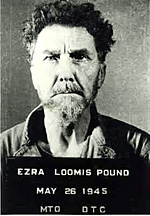
Ezra Pound, 26 May 1945
[»»]
Jonathan Morse: The Startle Reflex: Some Episodes from the Lives of Ezra Pound’s Language
[»»]
Jennifer Moxley: Rimbaud’s Foolish Virgin, Wieners’s “Feminine Soliloquy,” and the Metaphorical Resistance of the Lyric Body
[»»]
Sandeep Parmar: Mina Loy’s ‘Colossus’ and the Myth of Arthur Cravan
[»»]
Brian M. Reed: ‘Lost Already Walking’: Caroline Bergvall’s ‘Via’
[»»]
Anthony Stephens: Reflecting tragedy: Nietzsche, Lacan, Narcissus
[»»]
John Temple: Haven of the Heart: The Poetry of John Wieners (over 80 pages).
[»»]
John Emil Vincent: Escaping the future: John Ashbery’s «Girls on the run»
Poems
[»»]
Robert Adamson: Two poems (for Joanne Kyger)
[»»]
Louis Armand: Six Parts for a Requiem
[»»]
Jen Crawford: sixteen
[»»]
Laurie Duggan: Two poems from ‘The skies over Thanet’
[»»]
Joel Deane: Tuk-tuk
[»»]
Jesse Glass: Two poems
[»»]
Scott Glassman and Sheila E. Murphy: from «Quaternity»
[»»]
Philip Hammial: Two poems
[»»]
Ella Holcombe : The magazine
[»»]
Vincent Katz: Three poems
[»»]
Poems by Ko Un, translated from Korean by Brother Anthony of Taizé, Young-moo Kim, and Gary Gach
[»»]
Katy Lederer: In the Hole
[»»]
Philip Metres: The Old Haunts: A Guided Tour
[»»]
Carol Mirakove: Five poems
[»»]
Aryanil Mukherjee: Two Poems
[»»]
John Newlove: Three poems
[»»]
Benjamin Paloff: Four poems
[»»]
Tomaž Šalamun: Two poems, trans. Brian Henry
[»»]
Peter Dale Scott: Five poems
[»»]
Spencer Selby: Text From My Visual Book
[»»]
Elizabeth Smither: Practising scales
[»»]
Grzegorz Wróblewski: Two poems: Migraine; Jesse Owens and Luz Long
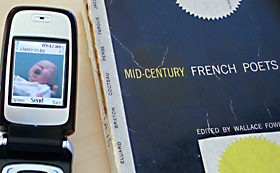
Photo: John Tranter
|
Canadian Poetry:
Language Acts: Anglo-Québec Poetry, 1976 to the 21st Century
Editors: Jason Camlot & Todd Swift
[»»]
Jason Camlot and Todd Swift: Introduction to «Language Acts: Anglo-Québec Poetry, 1976 to the 21st Century» Jacket Feature
[»»]
Robert Allen: Seven poems
[»»]
Oana Avasilichioaei: from «Gossip in the Valley»
[»»]
Stephanie Bolster: Six poems
[»»]
Asa Boxer: Four poems
[»»]
Jason Camlot: The Debaucher
[»»]
Angela Carr: Six Poems from the Rose Concordance
[»»]
Leonard Cohen: Three poems
[»»]
Mary di Michele: Four poems
[»»]
Endre Farkas: Four poems
[»»]
Raymond Filip: Three poems
[»»]
Jon Paul Fiorentino: Five poems
[»»]
artie gold: Five Jockey Poems
[»»]
Michael Harris: Five poems
[»»]
D.G. Jones: Six poems
[»»]
Steve Luxton: Four poems
[»»]
David McGimpsey: Four poems
[»»]
Donald McGrath: Five poems
[»»]
Stephen Morrissey: Three poems
[»»]
Erín Moure: Map of Calgary
[»»]
Robyn Sarah: Six poems
[»»]
David Solway: Five poems
[»»]
Carmine Starnino: Five poems
[»»]
Andrew Steinmetz: Five poems
[»»]
Nathalie Stephens: Four poems
[»»]
Todd Swift: Four poems
[»»]
Ruth Taylor: Five poems
[»»]
Peter Van Toorn: Six poems
Reviews
Language Poetry by the Bay: James Sherry: «The Grand Piano» Project:
…an ongoing experiment in collective autobiography by ten writers identified with Language poetry in San Francisco. It takes its name from a coffeehouse at 1607 Haight Street, where from 1976–79 the authors took part in a reading and performance series. The writing project, begun in 1998, was undertaken as an online collaboration, first via an interactive web site and later through a listserv.
[»»] «The Grand Piano» Part 3 reviewed
Earlier reviews of the project:
[»»] «The Grand Piano» Part 1 — in Jacket 32
[»»] «The Grand Piano» Part 2 — in Jacket 32
[»»]
Li Yun Alvarado: «How Long She’ll Last in This World», by María Meléndez
[»»]
Cristiana Baik: «DICTEE» by Theresa Hak Kyung Cha
[»»]
Douglas Barbour: «The Goldfinches of Baghdad» by Robert Adamson
[»»]
Christopher Barnes: «Lemon Shark» by Luke Beesley
[»»]
Ben Lyle Bedard: «REAL» by Stephen Ratcliffe
[»»]
Joel Bettridge: «Mirrors for Gold», by Roberto Tejada
[»»]
Lisa Bower: «Erosion’s Pull», by Maureen Owen
[»»]
Lisa Bower: «Letter from the Lawn» by Bobbi Lurie
[»»]
Joseph Bradshaw: «Inbox: (A Reverse Memoir)», Noah Eli Gordon
[»»]
Norene Cashen: «Cleavage» by Chris Tysh
[»»]
Matthew Cooperman: «A Fiddle Pulled from the Throat of a Sparrow», by Noah Eli Gordon
[»»]
Two views of Cuban poet José Kozer: Eugenia Demuro introduces Stet. by José Kozer. Trans. Mark Weiss, and…
[»»]
Christopher Winks analyses the poetry against a background of Adorno’s thinking: «Stet: Selected Poems», by José Kozer, translated by Mark Weiss
[»»]
Mark Dickinson: «The Moon Sees the One» by Candice Ward
[»»]
Alexander Dickow: «I’m The Man Who Loves You», by Amy King
[»»]
Sarah Dowling: «The Material of Poetry: Sketches for a Philosophical Poetics», by Gerald Bruns.
[»»]
Michael Duszat: «An Elemental Thing», by Eliot Weinberger
[»»]
Curtis Faville: Aram Saroyan: «Complete Minimalist Poems», and Robert Grenier: «100 Sentences / 100 Phrases». Translated from English into French by Martin Richet with the Author.
[»»]
Forrest Gander: «A Worldly Country» by John Ashbery
[»»]
Alan Gilbert: «How to Read a Poem» by Terry Eagleton
[»»]
Daniel Godston: «Blue Lash» by James Armstrong
[»»]
Daniel Godston: «Fulcrum: an annual of poetry and aesthetics» Number 5, 2006 (edited by Philip Nikolayev and Katia Kapovich)
[»»]
Piotr Gwiazda: Professing Poetry: a review of «Poetry and Pedagogy: The challenge of the contemporary», edited by Joan Retallack and Juliana Spahr
[»»]
Tom Hibbard: «Infinity Subsections» by Mark DuCharme
[»»]
Julia Istomina: «Rise Up», by Matthew Rohrer
[»»]
Tim Keane: «The Poems of Catullus: A Bilingual Edition», translated with commentary by Peter Green
[»»]
Astrid Lorange: «The Material Poem» edited by James Stuart
[»»]
Nicole Mauro: «Cornstarch Figurine» by Elizabeth Treadwell
[»»]
Carol Middleton: «About Writing, Seven Essays, Four Letters and Five Interviews», by Samuel R Delany
[»»]
Micaela Morrissette: «The Open Curtain», by Brian Evenson
[»»]
Micaela Morrissette: «Bornholm Night-Ferry», by Aidan Higgins
[»»]
Micaela Morrissette: «The Exquisite», by Laird Hunt
[»»]
Micaela Morrissette: «North & South», by Martha King
[»»]
Richard Owens: «Black Diamond Golden Boy Takes Bull By Horns» by Geoffrey Gatza
[»»]
Craig Santos Perez: «Puerta Del Sol» by Francisco Aragón
[»»]
Peter Robinson: «The Collected Poems of Ted Berrigan» edited by Alice Notley with Anselm Berrigan and Edmund Berrigan, Introduction and Notes by Alice Notley
[»»]
Larissa Shmailo: «Letters from Aldenderry», by Philip Nikolayev
[»»]
James Stuart: «Mediated», by Carol Mirakove, and «The Arts of Islam: Treasures from the Nasser D Khalili Collection»
|

Arthur Schlesinger Jr, 1960s
The Preservative Qualities of the
Martini Diet
When Schlesinger turned 60, he became more aware of his age. After a trip to the cathedral in Florence, he wrote: “As I went into the Duomo, it occurred to me that I have been visiting churches in Europe for 45 years, and that they have really done very little for me — my fault, not theirs, of course; but there it is. Why should I waste my declining years going into churches?… I will simplify life by abandoning the inspection of churches, as in earlier years I have abandoned ballet, metaphysics, linguistics and other subjects that, however estimable, are, alas, not for me.” A decade later, lunching with two younger men in 1987, Schlesinger observed, “I could not help noting the generational differences in diet. I had a martini and grilled double lamb chops. They had Perrier and chef’s salad. I suppose that their diet is better for them. But mine is more fun. I understand the disappearance of cigarettes these days; they are poison. But why has hard liquor, the staff of life, yielded to white wine and, heaven help us, Perrier?” In early 2007, Schlesinger died as he had lived: at work on a book... and out on the town (he was at a Manhattan restaurant on the night he was fatally stricken). [from the Washington Post, Sunday, October 7, 2007; Page BW03]
[Note: Arthur Schlesinger Jr. lived to the age of 89. I should be so lucky. — J.T.]

|


